Geospatial Analysis of Shoreline Shifts in the Indus Delta Using DSAS and Satellite Data
Abstract
1. Introduction
2. Study Area
3. Data and Methodology
3.1. Satellite Data
3.2. Shoreline Extraction
3.2.1. Rationale for Choosing NDWI and MNDWI
3.2.2. Accuracy Assessment
3.3. Baseline and Transect Generation
3.4. Statistical Analysis of Climatic Drivers
4. Result
4.1. Shoreline Change Analysis by Using EPR, LRR, and NSM
4.2. Correlation Between Shoreline Change and Climatic Variables
5. Discussions
5.1. Shoreline Transition in the Indus Delta
5.2. Climatic Factors Affecting Shoreline Dynamics
5.3. Human Activities and Shoreline Degradation
5.4. Integrated Mitigation Strategies
5.5. Implications for Future Research
5.6. Methodological Considerations and Limitations
6. Conclusions
Author Contributions
Funding
Data Availability Statement
Conflicts of Interest
References
- Addo, K.A.; Walkden, M.; Mills, J.P. Detection, measurement and prediction of shoreline recession. ISPRS J. Photogramm. Remote Sens. 2008, 63, 543–558. [Google Scholar] [CrossRef]
- Oyedotun, T.D. Shoreline geometry: DSAS as a tool for historical trend. Geomorphol. Tech. 2014, 3, 12. [Google Scholar]
- Wong, C.; Williams, C.; U, C.; Schelle, P.; J, P. World’s Top 10 Rivers at Risk. 2007. WWF International. Gland, Switzerland. Global Forest Resources Assessment 2020. Food and Agriculture Organization of the United Nations. Available online: https://www.researchgate.net/publication/23778568_World%27s_Top_10_Rivers_at_RiskFAO (accessed on 27 August 2024).
- Al-Tahir, R.; Ali, A. Assessing land cover changes in the coastal zone. Surv. Land Inf. Sci. 2004, 64, 107–112. [Google Scholar]
- Esmail, M.; Mahmod, W.E.; Fath, H. Assessment and prediction of shoreline change using multi-temporal satellite images and statistics: Case study of Damietta coast, Egypt. Appl. Ocean Res. 2018, 82, 274–282. [Google Scholar] [CrossRef]
- Siyal, A.A.; Solangi, G.S.; Siyal, P.; Babar, M.M.; Ansari, K. Shoreline change assessment of Indus delta using GIS-DSAS and satellite data. Reg. Stud. Mar. Sci. 2022, 53, 102405. [Google Scholar] [CrossRef]
- Neumann, B.; Vafeidis, A.T.; Zimmermann, J.; Nicholls, R.J. Future coastal population growth and exposure to sea-level rise and coastal flooding—A global assessment. PLoS ONE 2015, 10, e0118571. [Google Scholar] [CrossRef]
- Kummu, M.; De Moel, H.; Salvucci, G.; Viviroli, D.; Ward, P.J. Over the hills and further away from coast: Global geospatial patterns of human and environment over the 20th-21st centuries. Environ. Res. Lett. 2016, 11, 034010. [Google Scholar] [CrossRef]
- Thieler, E.R.; Himmelstoss, E.A.; Zichichi, J.L.; Ergul, A. Digital Shoreline Analysis System (DSAS) Version 4.0An ArcGIS Extension for Calculating Shoreline Change; U.S. Geological Survey Open-File Report 2008-1278; US Geological Survey: Reston, VA, USA, 2009.
- Wang, X.; Xie, S.; Zhang, X.; Chen, C.; Guo, H.; Du, J.; Duan, Z. A robust multi-band water index (MBWI) for automated extraction of surface water from Landsat 8 OLI imagery. Int. J. Appl. Earth Obs. Geoinf. 2018, 68, 73–91. [Google Scholar] [CrossRef]
- Özpolat, E.; Demir, T. The spatiotemporal shoreline dynamics of a delta under natural and anthropogenic conditions from 1950 to 2018: A dramatic case from the Eastern Mediterranean. Ocean Coast. Manag. 2019, 180, 104910. [Google Scholar] [CrossRef]
- Xu, H. Modification of normalised difference water index (NDWI) to enhance. Int. J. Remote Sens. 2006, 27, 3025–3033. [Google Scholar] [CrossRef]
- Milliman, J.D.; Farnsworth, K.L. River Discharge to the Coastal Ocean: A Global Synthesis; Cambridge University Press: Cambridge, UK, 2011. [Google Scholar] [CrossRef]
- Kidwai, S.; Amjad, S.; Akhtar, N. Coastal ecosystems of Pakistan: Statusand trends. Reg. Stud. Mar. Sci. 2019, 28, 100588. [Google Scholar]
- Food and Agriculture Organization of the United Nations. Global Forest Resources Assessment 2020; Food and Agriculture Organization of the United Nations: Rome, Italy, 2020. [Google Scholar]
- Asif, I.; Tabrez, A.; Tabrez, S. The Impact of Sea Level Rise on Pakistan’s Coastal Zones in A Climatic Change Scenario. In Proceedings of the 2nd International Maritime Conference, Karachi, Pakistan, 29–31 January 2008. [Google Scholar] [CrossRef]
- Khan, A.A.; Haredy, R.; Inam, A. Geochemistry and Sedimentary Sources of the Surface Sediments from the Continental Shelf off the Indus Delta, Pakistan. Int. J. Mar. Sci. 2020, 36, 61–74. [Google Scholar] [CrossRef]
- Kılar, H. Shoreline change assessment using DSAS technique: A case study on the coast of Meric Delta. Reg. Stud. Mar. Sci. 2022, 57, 1027–1037. [Google Scholar] [CrossRef]
- McFeeters, S. The use of the Normalized Difference Water Index (NDWI) in the delineation of open water features. Int. J. Remote Sens. 1996, 17, 1425–1432. [Google Scholar] [CrossRef]
- Himmelstoss, E.A.; Henderson, R.E.; Kratzmann, M.G.; Farris, A.S.; Weber, K.M. Digital Shoreline Analysis System (DSAS) Version 5.1 User Guide; U.S. Geological Survey Open-File Report 2021–1091; US Geological Survey: Reston, VA, USA, 2021; 104p. [CrossRef]
- Ji, L.; Zhang, L.; Wylie, B.; Rover, J. On the terminology of remote sensing image classification. Remote Sens. Environ. 2009, 113, 1343–1351. [Google Scholar] [CrossRef]
- Rokni, K.; Ahmad, A.; Selamat, A.; Hazini, S. Water featureextraction and change detection using multitemporal Landsat imagery. Remote Sens. 2014, 6, 4173–4189. [Google Scholar] [CrossRef]
- Kuleli, T.; Guneroglu, A.; Karsli, F.; Dihkan, M. Automatic detection of shoreline change on coastal Ramsar wetlands of Turkey. Ocean Eng. 2011, 38, 1141–1149. [Google Scholar] [CrossRef]
- Otsu, N. A threshold selection method. IEEE Trans. Syst. Man Cybern. 1979, 9, 62–66. [Google Scholar] [CrossRef]
- Konstantinou, A.; Scott, T.; Masselink, G.; Stokes, C.; Conley, D.; Castelle, B. Satellite-based shoreline detection along high-energy macrotidal coasts and influence of beach state. Mar. Geol. 2023, 462, 107082. [Google Scholar] [CrossRef]
- Ali Abd Al-Hameed, K. Spearman’s correlation coefficient in statistical analysis. Int. J. Nonlinear Anal. Appl. 2022, 13, 3249–3255. [Google Scholar] [CrossRef]
- Helsel, D.R.; Hirsch, R.M.; Ryberg, K.R.; Archfield, S.A.; Gilroy, E.J. Statistical Methods in Water Resources; U.S. Geological Survey Techniques and Methods, Book 4, Chapter A3; US Geological Survey: Reston, VA, USA, 2020; 458p. [CrossRef]
- Muñoz Sabater, J. ERA5-Land hourly data from 1950 to present. Clim. Data Store (CDS) 2019, 10. [Google Scholar] [CrossRef]
- Bandhawa, K.L.; Kumar, P.; Mishra, V. Evaluation of ERA5-Land and MERRA-2 reanalysis datasets for monitoring meteorological drought over South Asia. J. Hydrol. Reg. Stud. 2023, 47, 101395. [Google Scholar] [CrossRef]
- Giosan, L.; Syvitski, J.; Constantinescu, S.; Day, J. Climate change: Protect the world’s deltas. Nature 2014, 516, 31–33. [Google Scholar] [CrossRef]
- Basson, T.; Schultz, B.; González-Villareal, F. Final report of IPOE for review of studies on water escapages below Kotri Barrage. Hydraul. Eng. 2018. [Google Scholar] [CrossRef]
- Tunio, I.A.; Kumar, L.; Memon, A.; Mahessar, A.; Kandhir, A.; Memon, S. Sediment transport dynamics during a super flood: A case study of the 2010 super flood at the Guddu Barrage on the Indus River. J. Pre-Proof 2024, 39, 683–701. [Google Scholar] [CrossRef]
- Syvitski, J.P.M.; Saito, Y. Morphodynamics of deltas under the influence of humans. Glob. Planet. Change 2007, 57, 261–282. [Google Scholar] [CrossRef]
- Besset, M.; Billi, P.; Fazzini, M. Multi-decadal variations in delta shorelines and their relationship to river sediment supply: An assessment and review. Earth-Sci. Rev. 2019, 191, 1–24. [Google Scholar] [CrossRef]
- Giosan, L.; Clift, P.D.; Blusztajn, J.; Khan, M.A. On the control of climate- and human-modulated fluvial sediment delivery on river delta development: The Indus. Geology 2006, 34, 937–940. [Google Scholar]
- Komar, P.D. Beach Processes and Sedimentation, 2nd ed.; Prentice Hall: Upper Saddle River, NJ, USA, 1998. [Google Scholar]
- Anthony, E.J.; Smith, D.; Ramm, A. Monsoon wind influence on sediment transport and erosion in deltaic coasts. Coast. Eng. 2022, 177, 103997. [Google Scholar] [CrossRef]
- Williams, S.J.; Flanagan, L.B. Storm surge impacts on sediment deposition and coastal morphology. J. Coast. Res. 2020, 36, 789–803. [Google Scholar] [CrossRef]
- Giri, C.; Ochieng, E.; Tieszen, L.L.; Zhu, Z.; Singh, A.; Loveland, T.; Masek, J.; Duke, N. Status and distribution of mangrove forests of the world using earth observation satellite data. Glob. Ecol. Biogeogr. 2011, 20, 154–159. [Google Scholar] [CrossRef]
- Saifullah, S.M.; Ismail, A. Assessment of mangrove forests in the northwestern Indus Delta: Population structure and environmental characteristics. J. For. Res. 2015, 26, 123–134. [Google Scholar]
- Uddin, M.K.; Rahman, M.A.; Islam, M.R. Mangrove restoration and its impact on shoreline stabilization in deltaic regions. Wetl. Ecol. Manag. 2022, 30, 45–60. [Google Scholar]
- Nienhuis, P.H.; Leuven, J.R.; Winterwerp, J.C. Sediment redistribution under tidal and wave energy in deltaic systems. Mar. Geol. 2020, 429, 106282. [Google Scholar] [CrossRef]
- Syvitski, J.P.M.; Kettner, A.J.; Overeem, I.; Hutton, E.W.H.; Hannon, M.T.; Brakenridge, G.R.; Day, J.; Vörösmarty, C.; Saito, Y.; Saito, L.; et al. Sinking deltas due to human activities. Nat. Geosci. 2009, 2, 681–686. [Google Scholar] [CrossRef]
- Tessler, Z.D.; Vörösmarty, C.J.; Grossberg, M.; Gladkova, I.; Aizenman, H.; Syvitski, J.P.M.; Foufoula-Georgiou, E. Profiling risk and sustainability in coastal deltas of the world. Science 2015, 349, 638–643. [Google Scholar] [CrossRef] [PubMed]
- Anthony, E.J. Wave influence in the construction, shaping, and destruction of river deltas: A review. Mar. Geol. 2015, 361, 53–78. [Google Scholar] [CrossRef]
- Khan, A.R.; Ab Razak, M.S.B.; Yusuf, B.B.; Shafri, H.Z.B.M.; Mohamad, N.B. Future prediction of coastal recession using convolutional neural network. Estuar. Coast. Shelf Sci. 2024, 299, 108667. [Google Scholar] [CrossRef]
- Khan, A.R.; Ab Razak, M.S.B.; Yusuf, B.B.; Shafri, H.Z.B.M.; Mohamad, N.B. Harnessing artificial neural networks for coastal erosion prediction: A systematic review. Mar. Policy 2025, 178, 106704. [Google Scholar] [CrossRef]
- Scala, P.; Manno, G.; Lo Re, C.; Ciraolo, G. Update 2.0 to Coastal dynamics analyzer (CDA): A QGIS plugin for transect and area based analysis of coastal erosion. SoftwareX 2025, 30, 102170. [Google Scholar] [CrossRef]
- Gómez-Pazo, A.; Payo, A.; Paz-Delgado, M.V.; Delgadillo-Calzadilla, M.A. Open Digital Shoreline Analysis System: ODSAS v1.0. J. Mar. Sci. Eng. 2022, 10, 26. [Google Scholar] [CrossRef]
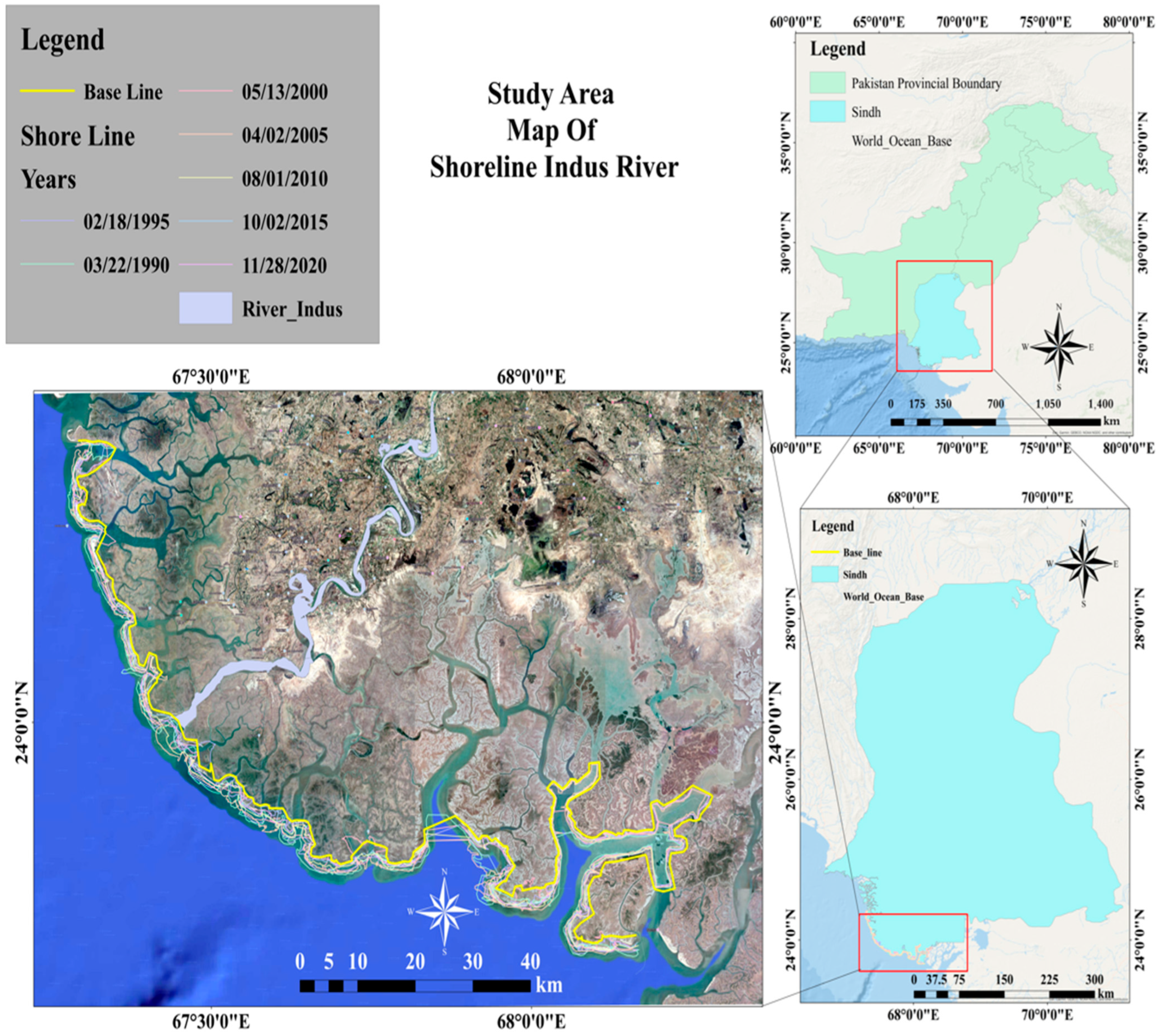
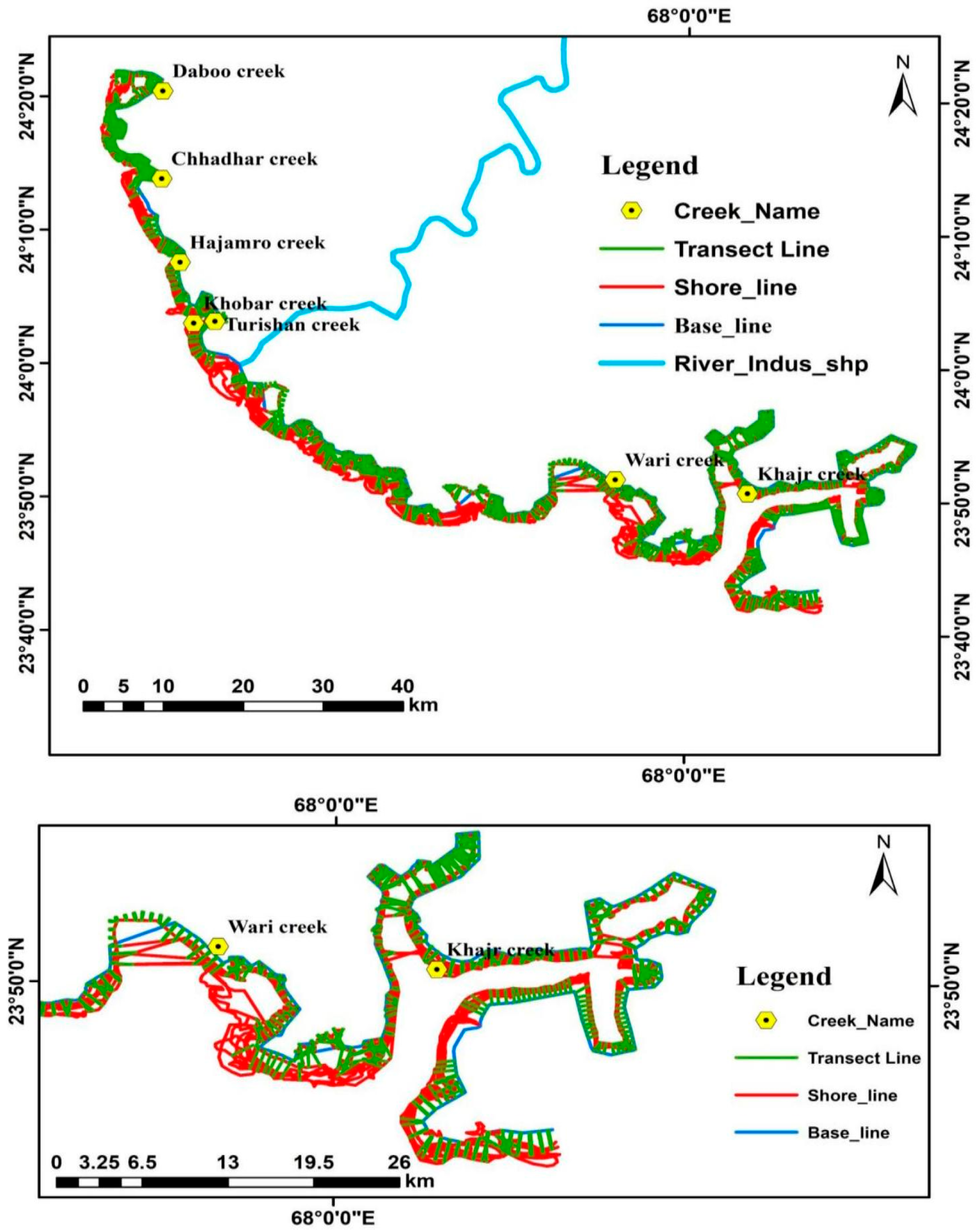


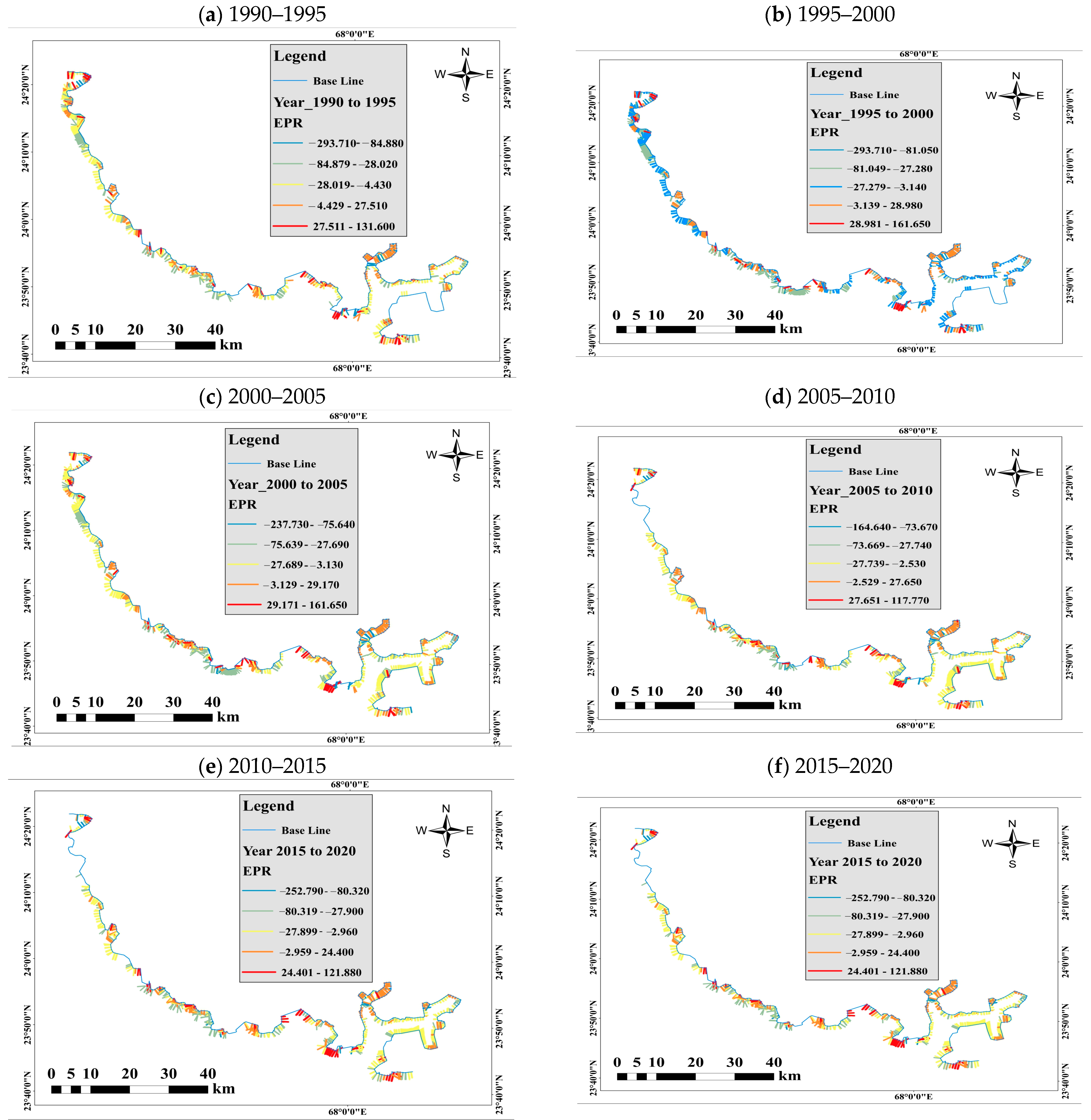
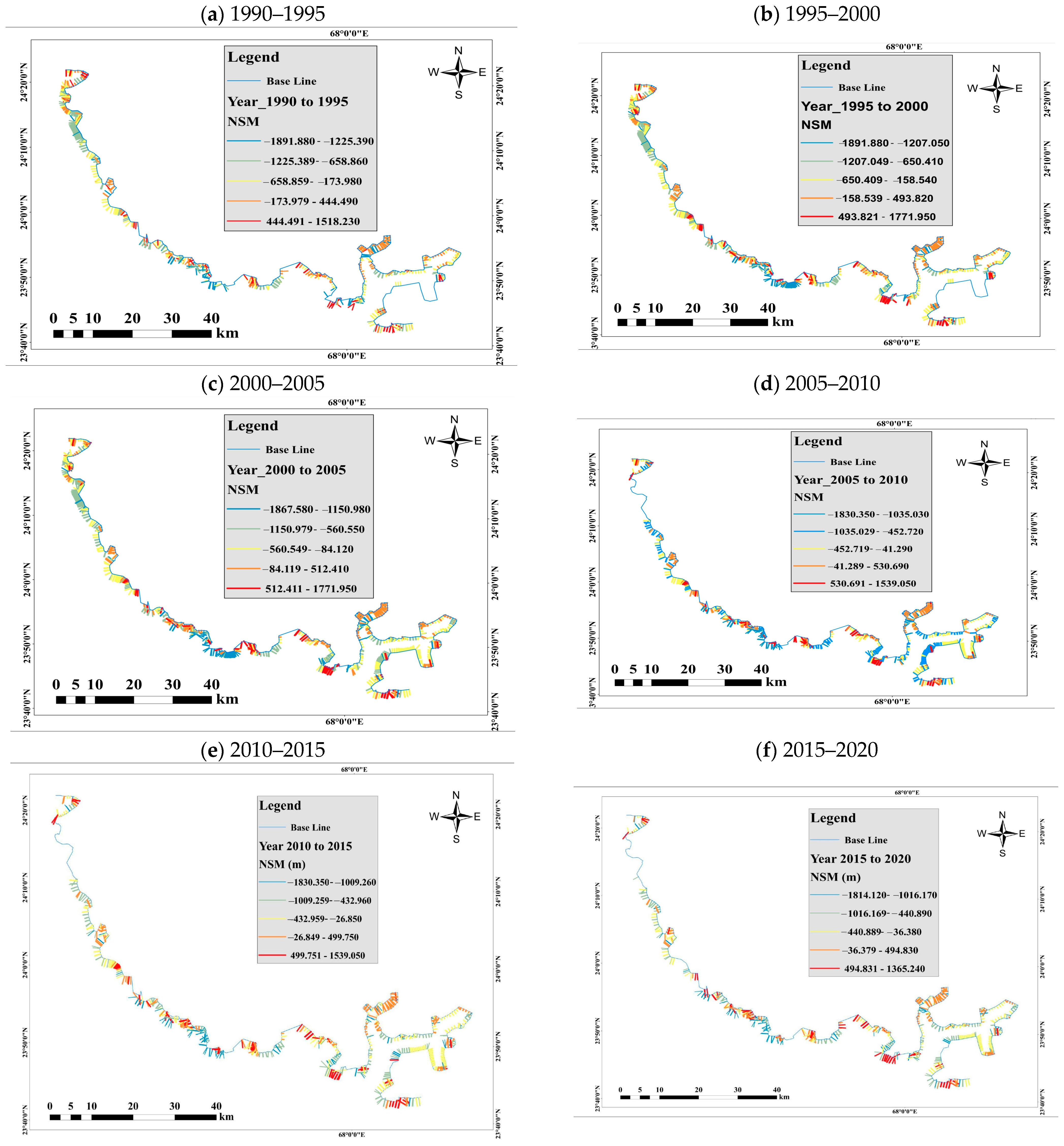
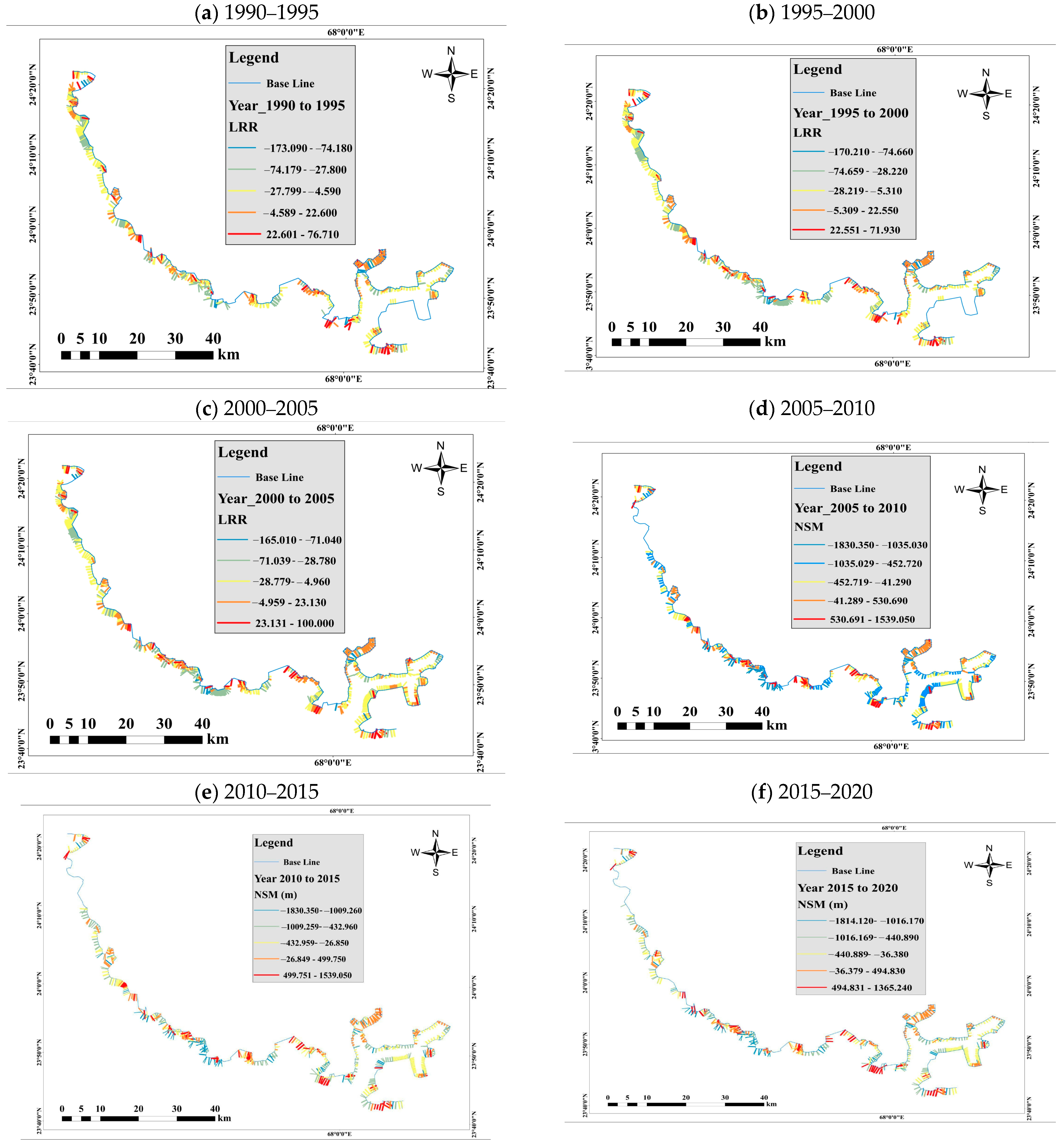

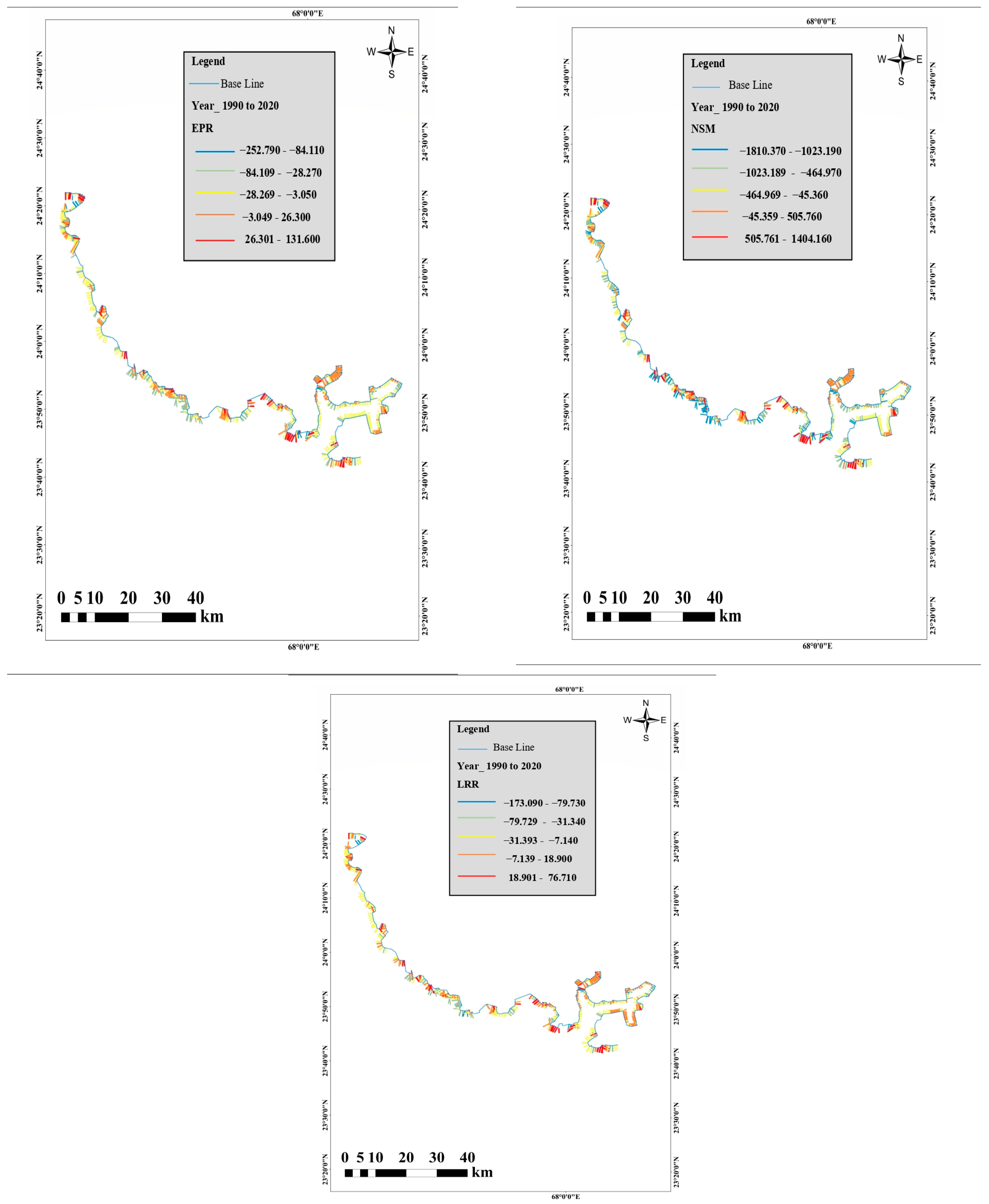
| Acquisition Date | Estimated Number of Images Used | Sensor | Path/Row | Bands Used | Wavelength (µm) | Spatial Resolution (m) |
|---|---|---|---|---|---|---|
| 22/03/1990 | 5–7 | Landsat 5 TM | 152/043 | Green (B2), NIR (B4), SWIR1 (B5), Red (B3) | 0.52–0.60; 0.76–0.90; 1.55–1.75; 0.63–0.69 | 30 |
| 18/07/1995 | 5–7 | Landsat 5 TM | 152/043 | Green (B2), NIR (B4), SWIR1 (B5), Red (B3) | 0.52–0.60; 0.76–0.90; 1.55–1.75; 0.63–0.69 | 30 |
| 13/05/2000 | 5–7 | Landsat 5 TM | 152/043 | Green (B2), NIR (B4), SWIR1 (B5), Red (B3) | 0.52–0.60; 0.76–0.90; 1.55–1.75; 0.63–0.69 | 30 |
| 02/04/2005 | 5–7 | Landsat 5 TM | 152/043 | Green (B2), NIR (B4), SWIR1 (B5), Red (B3) | 0.52–0.60; 0.76–0.90; 1.55–1.75; 0.63–0.69 | 30 |
| 01/08/2010 | 8–10 | Landsat 5 TM | 152/043 | Green (B2), NIR (B4), SWIR1 (B5), Red (B3) | 0.52–0.60; 0.76–0.90; 1.55–1.75; 0.63–0.69 | 30 |
| 02/10/2015 | 10–12 | Landsat 8 OLI | 152/043 | Green (B3), NIR (B5), SWIR1 (B6), Red (B4) | 0.53–0.59; 0.85–0.88; 1.57–1.65; 0.64–0.67 | 30 |
| 28/08/2020 | 10–12 | Landsat 8 OLI | 152/043 | Green (B3), NIR (B5), SWIR1 (B6), Red (B4) | 0.53–0.59; 0.85–0.88; 1.57–1.65; 0.64–0.67 | 30 |
| Metric | Description | Usage for Indus Delta | Interpretation |
|---|---|---|---|
| Net Shoreline Movement (NSM) | Calculates the overall distance a shoreline has moved over different points. It calculates over time the cumulative impacts of coastline change, therefore measuring both erosion and accretion. | Helps determine areas of the delta that are undergoing significant shoreline shifts. | Positive values indicate shoreline advance (accretion); negative values indicate shoreline retreat (erosion). |
| End Point Rate (EPR) | Calculates the annualized rate of shoreline movement by dividing the NSM by the time between the earliest and latest shoreline positions. It provides a simple, average rate of change per year. | Provides a straightforward view of the rate of erosion/accretion in the delta’s segments over the studied period. | Higher positive values indicate rapid accretion, while higher negative values indicate rapid erosion. |
| Linear Regression Rate (LRR) | Uses a linear regression model to fit a trend line across various coastline places, computing the change rate as the slope of this line. Less responsive to outliers and smooths short-term fluctuates. | Provides a robust overall trend of shoreline change across multiple positions, ideal for areas with episodic events or irregular shorelines, like the delta. | Positive values indicate overall shoreline advance; negative values indicate shoreline retreat, making it a robust method for analyzing dynamic environments. |
| Digital Shoreline Analysis System (DSAS) | An ArcGIS tool extension that automates shoreline change calculations by generating transects across coastline positions and calculates metrics like NSM, EPR, and LRR. | Provides a consistent framework to calculate and analyze shoreline changes across various delta segments. | DSAS enables reliable, repeatable, and spatially consistent analysis essential for monitoring and managing coastal dynamics in regions like the Indus Delta. |
| Year | Spearman’s ρ (Rs) | p-Value |
|---|---|---|
| 1990 | −0.679 | 0.00051 |
| 1995 | +0.186 | 0.408 |
| 2000 | −0.663 | 0.00076 |
| 2005 | −0.409 | 0.059 |
| 2010 | −0.188 | 0.402 |
| 2015 | −0.181 | 0.419 |
| 2020 | +0.812 | <0.00001 |
| Statistical Result from 1990–2020 | |||
|---|---|---|---|
| Statistics | EPR(m·year−1) | NSM(m) | LRR(m·year−1) |
| Average | −29.94 | −246.17 | −29.5 |
| Max. | 131.6 | 1404.16 | 76.71 |
| Min. | −252.79 | −1810.37 | −173.09 |
| Standard Deviation | 82.04 | 810.21 | 59 |
Disclaimer/Publisher’s Note: The statements, opinions and data contained in all publications are solely those of the individual author(s) and contributor(s) and not of MDPI and/or the editor(s). MDPI and/or the editor(s) disclaim responsibility for any injury to people or property resulting from any ideas, methods, instructions or products referred to in the content. |
© 2025 by the authors. Licensee MDPI, Basel, Switzerland. This article is an open access article distributed under the terms and conditions of the Creative Commons Attribution (CC BY) license (https://creativecommons.org/licenses/by/4.0/).
Share and Cite
Batool, H.; He, Z.; Kalhoro, N.A.; Kong, X. Geospatial Analysis of Shoreline Shifts in the Indus Delta Using DSAS and Satellite Data. J. Mar. Sci. Eng. 2025, 13, 1986. https://doi.org/10.3390/jmse13101986
Batool H, He Z, Kalhoro NA, Kong X. Geospatial Analysis of Shoreline Shifts in the Indus Delta Using DSAS and Satellite Data. Journal of Marine Science and Engineering. 2025; 13(10):1986. https://doi.org/10.3390/jmse13101986
Chicago/Turabian StyleBatool, Hafsa, Zhiguo He, Noor Ahmed Kalhoro, and Xiangbing Kong. 2025. "Geospatial Analysis of Shoreline Shifts in the Indus Delta Using DSAS and Satellite Data" Journal of Marine Science and Engineering 13, no. 10: 1986. https://doi.org/10.3390/jmse13101986
APA StyleBatool, H., He, Z., Kalhoro, N. A., & Kong, X. (2025). Geospatial Analysis of Shoreline Shifts in the Indus Delta Using DSAS and Satellite Data. Journal of Marine Science and Engineering, 13(10), 1986. https://doi.org/10.3390/jmse13101986







